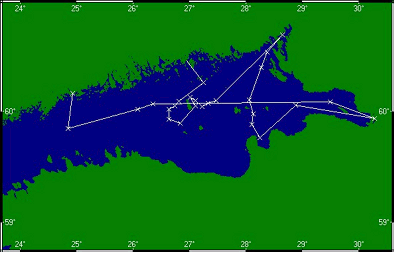Press release 2011-07-29 at 12:00
|
|

|
|
Research vessel Aranda.
Photo: Janne Bruun
|
The Finnish Environment Institute (SYKE) is sending the research vessel Aranda to investigate the conditions of the seabed in the Eastern Gulf of Finland. The seabed's radioactivity, oxygen conditions and the occurrence of fauna are studied not only in the Finnish but also in the Russian territorial waters where most of the seven-day expedition will be spent. In addition, sediment samples are collected extensively from the sea floor to be used in environmental research. Algae toxins and nutrient concentrations will also be monitored.
The multidisciplinary expedition is led by SYKE and involves 21 researchers from several research institutes. The Aranda sails from Kotka on 30 July. The vessel will also be open to the public when it visits the port of St Petersburg.
The Baltic Sea is the most radioactive sea in the world. Most of the radioactivity has sunk to the sediment on the seabed. The largest source of radiation in the Baltic Sea is the caesium 137 fallout from the Chernobyl nuclear disaster 25 years ago. In the Gulf of Finland, as well as the Baltic Sea as a whole, the worst fallout hit the area between Kotka and the Luga Bay. This research journey will shed new light on the radioactivity of the seabed and its fauna. More detailed results will follow later as the samples taken on the journey are examined more closely. Seabed boring samples can be used to investigate changes in the oxygen level and microbiota throughout the history of the Baltic Sea.
The oxygen conditions in the Eastern Gulf of Finland are generally better than in other parts of the Gulf or in the main basin of the Baltic Sea. Nonetheless, the lack of oxygen occasionally poses a problem in some deep basins in the Eastern Gulf of Finland. The expedition takes place during the average high season of cyanobacteria or blue-green algae. The Aranda will observe the blue-green algae conditions and measure the toxins which the blooming blue-green algae generate in the sea water.
"This will allow us to increase the up-to-date information about the Baltic Sea which is required by the EU’s Marine Strategy Framework Directive," says the expedition leader, Adjunct Professor Harri T. Kankaanpää of the Marine Research Centre of the Finnish Environment Institute SYKE.
The expedition also sets out to investigate the current nutrient conditions in areas where nutrient loads are expected to have diminished significantly as a result of improved wastewater purification in the St Petersburg region.
The expedition is led by Senior Researcher, Adjunct Professor Harri T. Kankaanpää of the Marine Research Centre of the Finnish Environment Institute SYKE. The team will return to Helsinki on 5 August.


|
|
|
|
The route of the research vessel mta Aranda during its COMBOT expedition from 30.7. to 5.8.2011.
|
|
More information
Expedition leader on the Aranda, Harri T. Kankaanpää, Senior Researcher, Marine Research Centre of SYKE, tel. +358 40 182 3185, firstname.lastname@ymparisto.fi
Head of marine geology research on the Aranda, Aarno Kotilainen, Research Professor, the Geological Survey of Finland GTK, tel. +358 400 626 939, firstname.lastname@gtk.fi
Head of radioactivity research on the Aranda, Iisa Outola, Senior Scientist, the Radiation and Nuclear Safety Authority Finland, tel. +358 9 759 88 507, firstname.lastname@stuk.fi
Aira Saloniemi, Chief Editor for Web Services, SYKE Communications, tel. +358 400 1488 75, firstname.lastname@ymparisto.fi